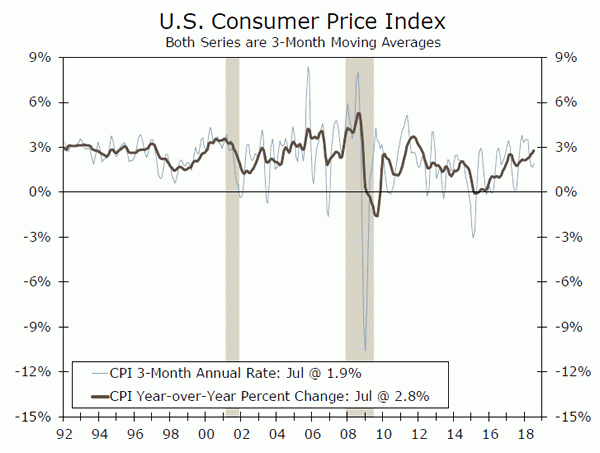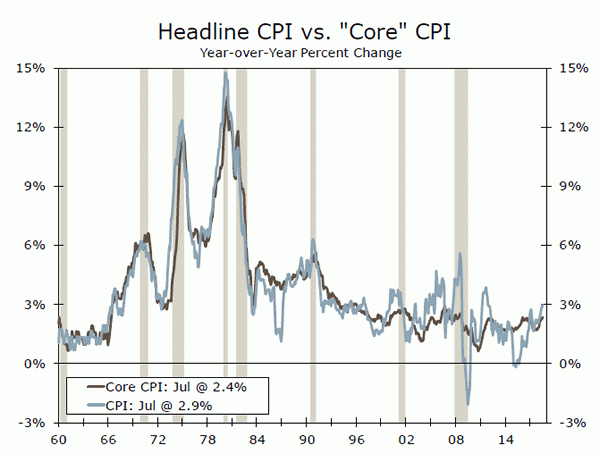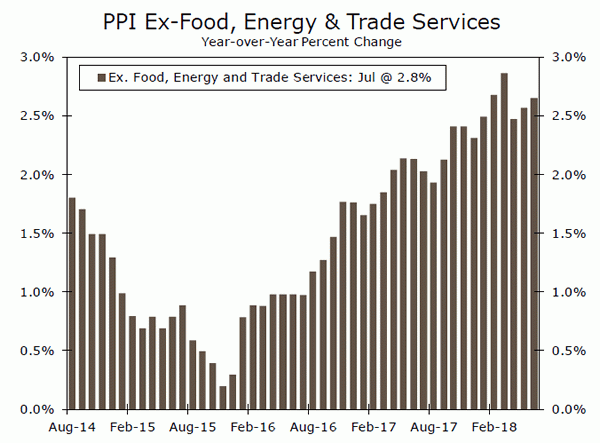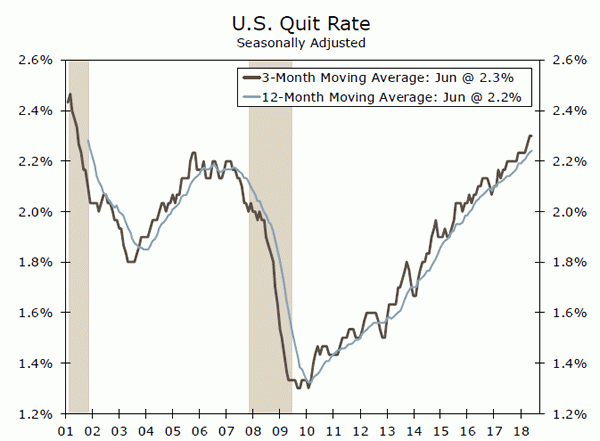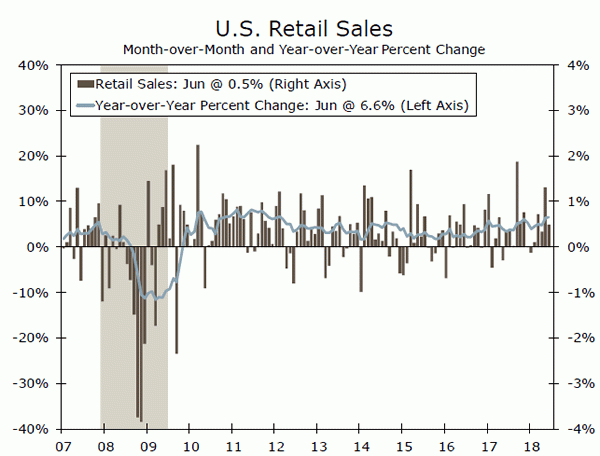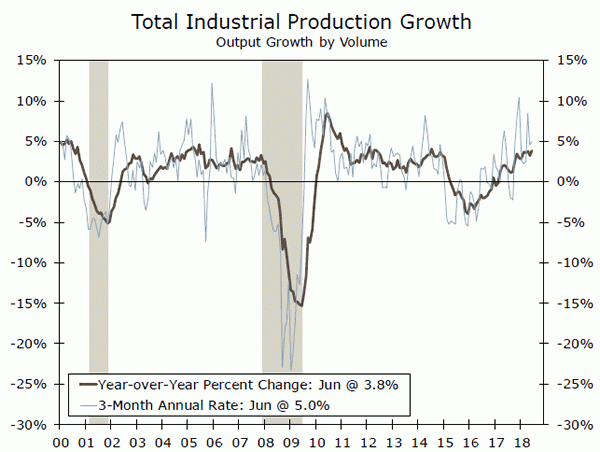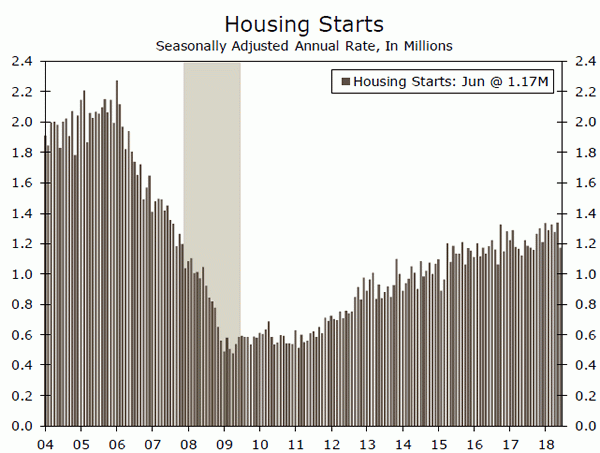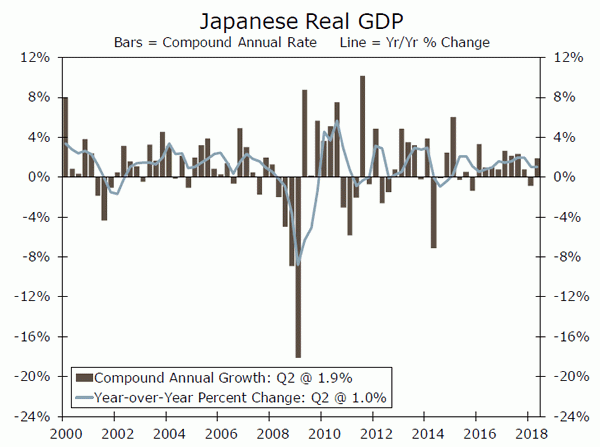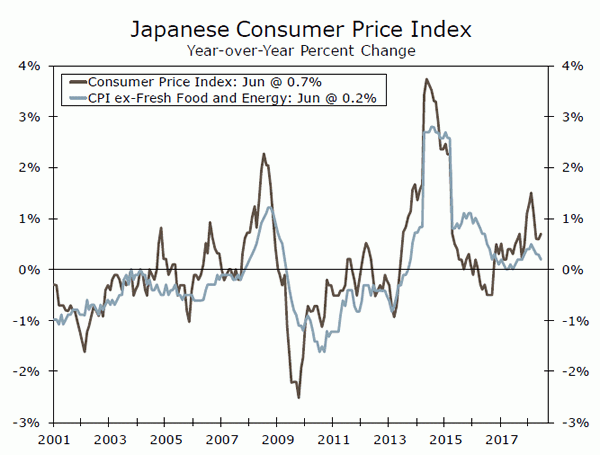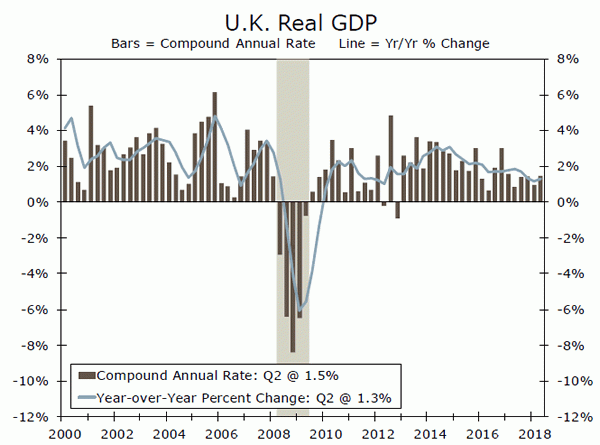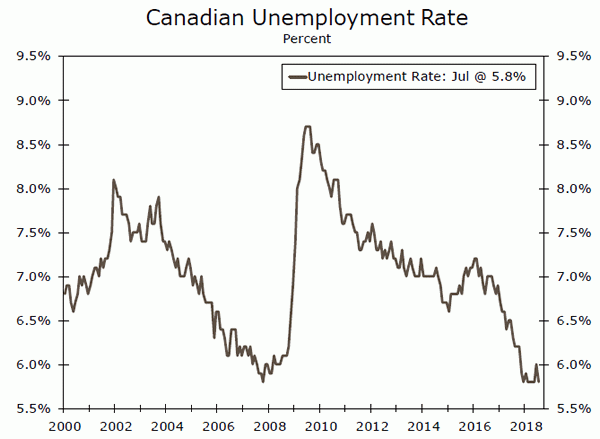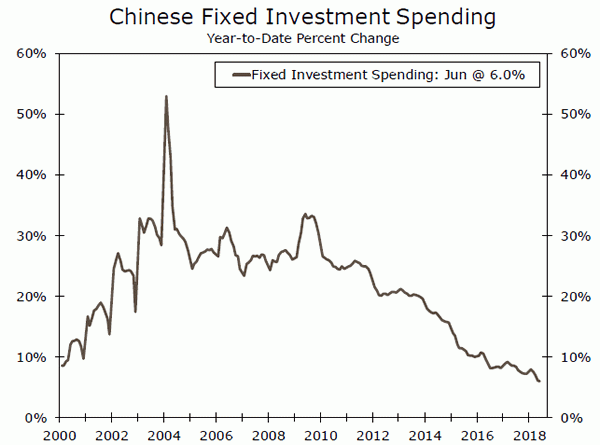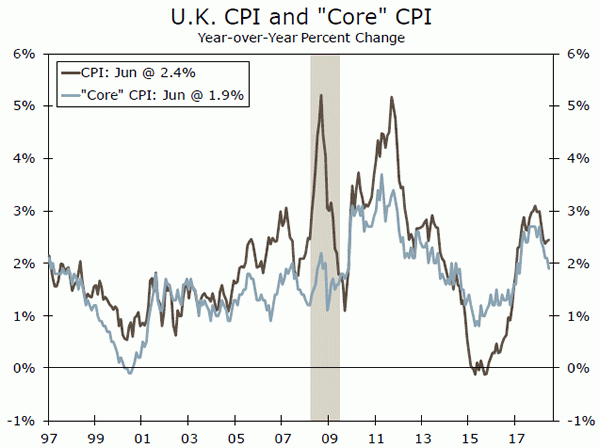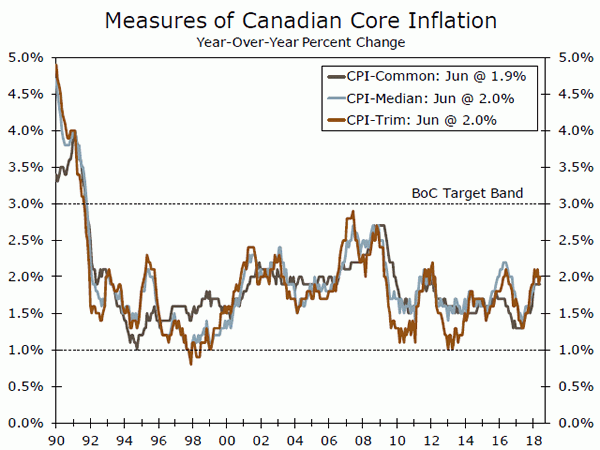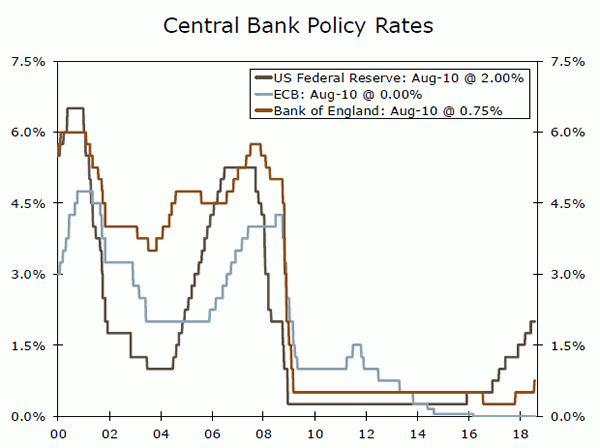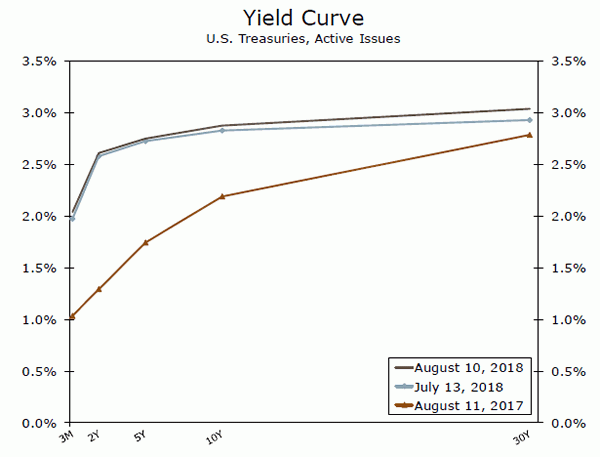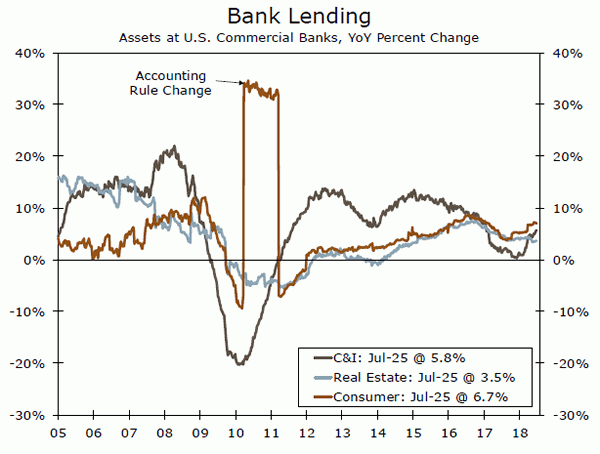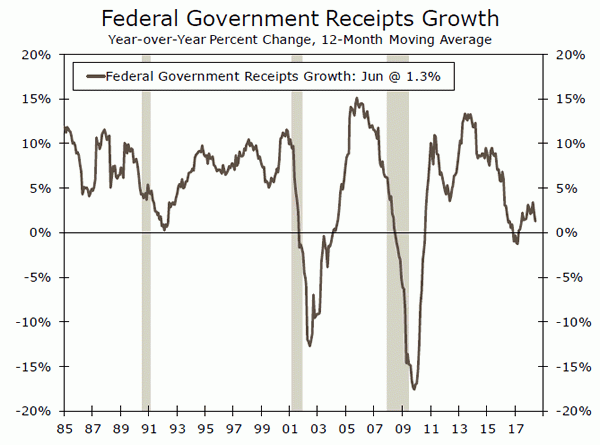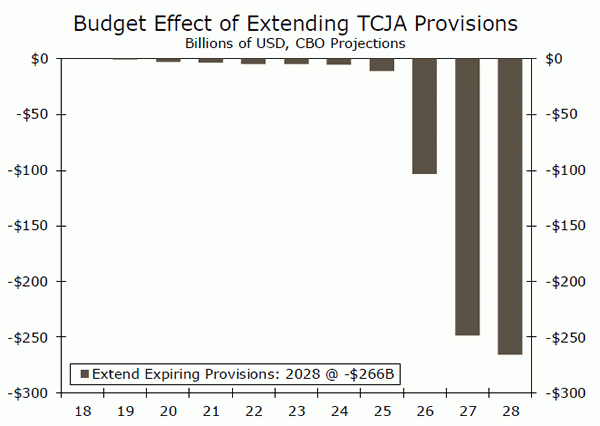U.S. Review
Prices Continue to Advance
- Consumer prices increased 0.2 percent in July, advancing to 2.9 percent on a year-to-year basis, the strongest pace in six years. The core CPI index also rose a strong 0.2 percent, bringing the year-to-year rate to 2.4 percent.
- The Producer Price Index showed no change in July. However, underlying details showed prices trending higher. Excluding food, energy and trade services, prices rose 0.3 percent.
- JOLTS data for June indicated that the number of open job positions remained near record highs at 6.7 million. The quits rate also remained elevated at 2.3 percent.
Prices Continue to Advance
This week offered few surprises in terms of economic data. Prices continue to gradually rise and evidence of a strong labor market continues to mount. We maintain our stance that the Fed should be on track for two more rate hikes this year in September and December, with two additional quarter-point hikes in 2019.
Consumer prices matched expectations and edged up 0.2 percent in July. The monthly gain kept the headline index at a 2.9 percent increase on a year-to-year basis, the fastest pace in six years. Energy prices were a drag on the headline figure and dropped 0.5 percent for the month, mostly the result of lower gas prices. Excluding food and energy prices, the core index also rose 0.2 percent during the month. Before rounding however, core prices came in on the high side of expectations and grew 0.24 percent, pushing prices 2.4 percent higher compared with last year. Much of the monthly increase in core prices was owed to a 0.3 percent gain in services, notably in housing, which also rose 0.3 percent. Vehicle prices also advanced, with a 1.3 percent rise for used vehicles. While increases were generally broad-based, apparel and medical care prices saw modest declines.
Meanwhile, the overall Producer Price Index fell short of expectations and showed no change in July. However, the underlying details showed that prices continue to trend higher. June’s soft topline reading was the result of a drag from declines in several volatile sectors. The trade services price index, which is measured by changes to retail and wholesale margins, fell 0.8 percent, while food decreased 0.1 percent and energy declined 0.5 percent. The “core-core” measure, which excludes food, energy and trade services, rose slightly more than expected and increased 0.3 percent during the month. Over the past 12 months, “corecore” prices for U.S. producers have now risen 2.8 percent. However, intermediate prices for processed goods were flat in July and input costs for services have slowed in comparison to earlier this year, an indication that price growth should be contained and continue to advance at a gradual pace.
We also received new data that reflect the underlying strength of the labor market. JOLTS data for June revealed that the number of job openings was essentially unchanged at 6.7 million during the month. However, job openings are near a record high and remain well ahead of the 6.1 million open positions posted a year ago. The number of job openings has also now exceeded the number of unemployed for the fourth consecutive month. Most industries saw the number of job openings increase in June, notably in financial activities and wholesale trade. The construction and manufacturing industries also saw the number of open positions increase during the month, both hitting fresh new cycle highs. The quit rate was essentially unchanged at 2.3 percent, but also sits near its highest point of the expansion. The elevated level of the quit rate signals that workers continue to have a high degree of confidence in the labor market. Quits also usually lead to a pay increase, which should help keep upward pressure on wages.
Initial jobless claims fell to 213,000 for the week of August 4. On a four-week moving average basis, jobless claims are well below the 241,500 registered in the same period last year. The continued low level of jobless claims is consistent with an increasingly shallow pool of available labor.
U.S. Outlook
Retail Sales • Wednesday
Retail sales rose 0.5 percent in June, while May’s gain was revised up to a strong 1.3 percent. Control group sales were flat on the month, which was not too concerning given the upward revisions to prior months. These retail sales figures are consistent with the 4.0 percent annualized rise in personal consumption expenditures registered in the second quarter. It is tempting to tie the second quarters’ big gain in consumer spending to the tax cuts; however, part of the strength reflects some catchup from the first quarter, which was, in part, negatively impacted by harsh winter conditions. Catchup effects, coupled with a weak print in June, do not provide great momentum for retail sales going into the third quarter. We expect some weakness to remain, and look for retail sales to rise only 0.1 percent in July. However, given a tight labor market and wage growth beginning to materialize, the current weakness in retail sales is unlikely to persist throughout the remainder of the year.
Previous: 0.5% Wells Fargo: 0.1% Consensus: 0.1% (Month-over-Month)
Industrial Production • Wednesday
Industrial production rose 0.6 percent in June. Due to supply disruptions from a major fire at a parts supplier the prior month, the gain was largely driven by a 7.8 percent bounce-back in motor vehicles and parts production. Mining output marked its fifth consecutive monthly gain, increasing 1.2 percent, as elevated energy prices drove production. Utilities output, however, fell 1.5 percent in June. June’s rise in production nudged capacity utilization back up to 78 percent. Despite remaining slightly below the long-run average of 79.8 percent, capacity constraints are evident in the supply chain, and continue to be supportive of increased investment spending and mounting price pressures. Given the strength of the ISM index, which sits at 58.1 as of July, we expect industrial activity to continue to advance to a level that is more consistent with the positive sentiment being expressed through various manufacturing surveys.
Previous: 0.6% Wells Fargo: 0.4% Consensus: 0.4% (Month-over-Month)
Housing Starts • Thursday
Housing starts declined 12.3 percent in June to a 1.173-million unit pace. Both single-family and multifamily starts fell. Given the continued tight supply of homes available for sale and fairly high levels of builder confidence, the recent weakness in housing starts is perplexing. Supply constraints may be at play. Higher input costs, such as lumber prices in light of tariffs on Canadian softwood lumber, are likely weighing on starts of lower priced homes, which do not have large enough profit margins to absorb increased costs. This may be adding to the continued drop in the share of consumers that feel now is a good time to buy a home, with the most often cited reason being the lack of affordable homes to choose from. Similarly, labor supply shortages may be weighing on builders’ ability to start projects. Despite these headwinds, and the weakness exhibited in June, we expect stronger job and income growth to push home buying higher in the coming months.
Previous: 1.173M Wells Fargo: 1.249M Consensus: 1.273M
Global Review
Lackluster Growth in Some Foreign Economies in Q2
- Real GDP in Japan grew at an annualized rate of 1.9 percent in Q2, reversing the modest contraction that occurred in Q1. But inflation remains very low in Japan.
- The British economy has expanded only 1.3 percent over the past four quarters. Uncertainty related to the Brexit negotiations remains high, which will keep the Bank of England cautious as it slowly hikes rates.
- In contrast, the Canadian economy appears to have turned in a solid quarter in Q2. The unemployment rate is back to its cycle low, which should lead to another rate hike by the end of the year.
GDP Growth Rebounds in Japan in Q2
Incoming data show that real GDP continued to grow in most major foreign economies in the second quarter, if only at lackluster rates. In Japan, GDP grew at an annualized rate of 1.9 percent on a sequential basis (see chart on front page). Not only was the outturn a bit stronger than most analysts had expected, but it more than offset the 0.9 percent contraction that occurred in the first quarter. Moreover, growth in the individual components of domestic demand was reasonably solid, with private consumption expenditures rising 2.8 percent and private non-residential investment climbing 5.2 percent.
The GDP outturn undoubtedly led to a sigh of relief at the Bank of Japan, which has been trying for years, without much success, to engineer a higher rate of inflation in the Japanese economy. The rebound in GDP growth in the second quarter is welcome, but it will take sustained growth at a strong rate to lead to a meaningful rise in CPI inflation in Japan, which is currently running below 1 percent (top chart). Consequently, the Bank of Japan is not likely to start removing policy accommodation anytime soon, which should limit the degree of any appreciation of the Japanese yen that may occur in coming months.
U.K. Economy Continues to Grow at a Modest Pace
Real GDP in the United Kingdom grew 0.4 percent (1.5 percent at an annualized rate) on a sequential basis in the second quarter (middle chart). The outturn was a tad stronger than the anemic 0.9 percent annualized growth rate that was registered in Q1. Personal consumption expenditures continued to grind higher and business fixed investment spending, which tumbled in Q1, rebounded in the second quarter.
That said, the British economy has expanded just 1.3 percent over the past four quarters, which is barely above stall speed. As we describe in more detail in a report that was published today, uncertainty related to the Brexit negotiations remains the elephant in the room. (See “U.K. Mid-Year Economic Outlook,” which is posted on our website.) A “hard” Brexit in March, should one occur, could potentially lead to further economic weakness. The Bank of England, which hiked rates 25 bps at its policy meeting last week, likely will proceed at a very slow pace until some of the uncertainty surrounding the U.K. economic outlook dissipates.
Canadian Economy Continues to Enjoy Solid Growth
Canada will not release its Q2 GDP data until later this month, but monthly economic indicators suggest that the Canadian economy grew at a solid rate in the second quarter. Monthly GDP rose by 0.5 percent in May, which followed the 0.1 percent gain registered in April. And it appears that growth started Q3 at a decent clip as employment shot up by 54.1K individuals in July. Strong employment gains in recent months have returned the unemployment rate to its cycle low of 5.8 percent in July (bottom chart). The Bank of Canada has raised its policy rate 50 bps so far this year, and we look for it to tack on another 25 bps increase later this year.
Global Outlook
China Fixed Investment Spending • Monday
Growth in investment spending reached its lowest rate on record in June, rising just 6 percent year-over-year as the Chinese economy continues its transition toward a consumption-oriented economic model. The run-up in investment spending over the past decade also resulted in a highly-leveraged corporate sector, which along with the broader economic transition has restrained China’s expansion. GDP growth decelerated slightly in Q2 to 6.7 percent year-over-year, and data on industrial production and retail sales also released on Monday should support the continued economic pivot. Although still at historically slow rates of growth, retail sales rebounded slightly in June, while industrial production growth continued its slowdown. Trade tensions have also reemerged this week as China and the U.S. imposed additional tariffs on each other’s exports. Although trade uncertainty and structural factors are present, we look for overall economic growth to slow only modestly in the coming quarters.
Previous: 6.0% Consensus: 6.0% (Year-over-Year, Year to Date)
United Kingdom CPI • Wednesday
Inflation in the U.K. has trended lower after a sharp drop in sterling drove up import prices and pushed the CPI above 3 percent in the wake of the Brexit referendum in 2016. Consumer price inflation was 2.4 percent in June, and we look for it to decline further to 2.3 percent in July. Amid slowing inflation and only tepid economic growth in Q1, the Bank of England (BoE) hiked rates 25 bps at its meeting last week. The BoE looked for domestic price pressures to pick back up as Brexit-related distortions fade, and today’s GDP print also showed that economic growth rebounded modestly in Q2, with real GDP growing 0.4 percent in the quarter. That said, Brexitrelated concerns have reemerged recently on whether the U.K. and the E.U. can reach an agreement on the future of their economic relationships by the March 2019 deadline. For now, we look for the BoE to tighten policy at a slow pace, given Brexit-related uncertainty and inflation that is already moving back toward target.
Previous: 2.4% Wells Fargo: 2.3% Consensus: 2.5% (Year-over-Year)
Canada CPI • Friday
The CPI in Canada rose 2.5 percent year-over-year in June, and various measures of core consumer price inflation have firmed within the Bank of Canada’s (BoC) target band in recent months. Monthly GDP growth has remained solid so far in April and May, putting overall Q2 GDP growth on track to surpass a 2 percent annualized pace. Firming inflation and solid economic growth led the BoC to hike its overnight lending rate 25 bps at its July meeting. But, in its accompanying statement, the BoC acknowledged rising trade concerns as a threat to its outlook. In terms of inflation, the Canadian dollar has weakened against the U.S. dollar in light of recent trade concerns, and new tariffs on U.S. imports should also push up prices in coming months. Rising external price pressures and an economy operating near full capacity support our forecast for the BoC to hike rates once more before the end of 2018.
Previous: 2.5% Wells Fargo: 2.6%
Point of View
Interest Rate Watch
Two Down, Two to Go, Right Charlie?
With two quarter-point rate hikes on the books for 2018 most analysts (ourselves included) expect the strong labor market and firming inflation to warrant two more rate hikes by the end of the year.
At an event in Chicago this week, that region’s Fed President Charles Evans considered the path for the FOMC in the context of fiscal stimulus and a hot economy.
Second quarter GDP came in at a scorching 4.1 percent annualized rate and the July jobs report showed the unemployment rate dipping back below 4 percent. On the inflation side of the mandate, the Fed’s preferred measure, the PCE deflator, puts prices up 2.2 percent on a year-over-year basis through June. The CPI index reports 2.9 percent price growth for the same period.
While he is not a voter this year, the comments from Chicago Fed President Evans may yet offer clues about a coming shift in policy guidance from the Fed.
A key consideration in that decision will likely be the natural rate of unemployment, or the jobless rate that could be sustained without putting upward pressure on prices.
In our view, the lack of substantive wage pressure in the current cycle warrants at least a degree of caution or skepticism in assigning too much emphasis on a given jobless rate as the magic number.
Former Fed Chair Janet Yellen often stressed that the unemployment rate was just one data point that needed to be considered in the broader context of the changing size of the labor force as well as levels of participation.
Based on our current forecast, we do not expect the 4.1 percent GDP growth rate in the second quarter to be repeated at any point in the foreseeable future. But we do anticipate further declines in the unemployment rate. Whether or not that translates into wage-push inflation will be the greater matter for consideration by the Fed. For now, we still anticipate two more rate hikes to finish the year with the fed funds rate at 2.50 percent.
Credit Market Insights
Sluggish Revolving Credit Growth
Consumer credit rose $10.2 billion in June, slowing from an increase of $24.3 billion in May. Much of the moderation came in revolving credit, which consists mostly of credit cards. Revolving credit declined 0.2 percent after increasing 11.2 percent in May. This turnaround from May puts revolving credit growth back on the softer trend seen through the first few months of the year. Even including May’s large gain, 2018 has seen the slowest first-half for revolving credit since 2013.
Credit growth can be a helpful proxy for consumers’ willingness to spend. Thus, the pullback could be concerning if it is the result of slower consumption in the face of higher interest rates, but retail sales and personal consumption were up solidly in Q2. Another explanation is that tax cuts and improving income prospects may be pushing down consumers’ need to borrow.
Looking at other forms of borrowing, nonrevolving credit, which includes student loans and car loans, has maintained a solid pace over the past few months and is up 4.4 percent since June of last year. Mortgage debt, which makes up the majority of household debt but is not included in the consumer credit report, was up a solid 3.9 percent in Q1 year-over-year.
Overall consumer spending looks to be in fairly good shape. Going forward, we expect disposable income growth to continue to strengthen and for spending to follow suit.
Topic of the Week
Tax Reform 2.0: The Sequel
The Tax Cuts and Jobs Act (TCJA) enacted into law at the end of last year was a significant change in U.S. policy that led to material changes in the economic outlook. Recently, talk in Washington, D.C. has begun to swirl about a potential “Tax Reform 2.0”. On July 24, Republican members of the House Ways and Means Committee circulated a two-page memo listing some high-level goals for Tax Reform 2.0. Given the impact the TCJA has had on the economy and financial markets, what are the implications of a possible tax reform sequel?
For now, details remain sparse. In short, however, most of the proposed changes in a possible tax reform encore are likely to be marginal rather than wholesale changes. The most ambitious aspect of the loosely outlined proposal is to make the individual tax cuts enacted last year permanent; at present, most of these cuts are scheduled to expire at the end of 2025. While we are skeptical this would be included in any final plan, were it to occur, there would likely be minimal short-run economic impact due to the back-loaded nature of the cuts. The long-run fiscal deterioration would be fairly large, however, and a more ominous debt outlook could cause long-term interest rates to rise a bit further.
Beyond this potential change, most of Tax Reform 2.0’s goals, such as expanding how 529 education accounts can be used or allowing families to access retirement accounts penalty-free when having a child, are unlikely to have a major macroeconomic impact in the context of the $20 trillion U.S. economy. In addition, the political calculus for passing a bill before the midterm elections in November looks a bit vexing, and a tight legislative calendar will likely be a second major hurdle. Thus, while tax reform 2.0 might come and go in the headlines over the coming months, we believe its near-term macroeconomic impact, should it become reality, would be far less significant than its predecessor.




